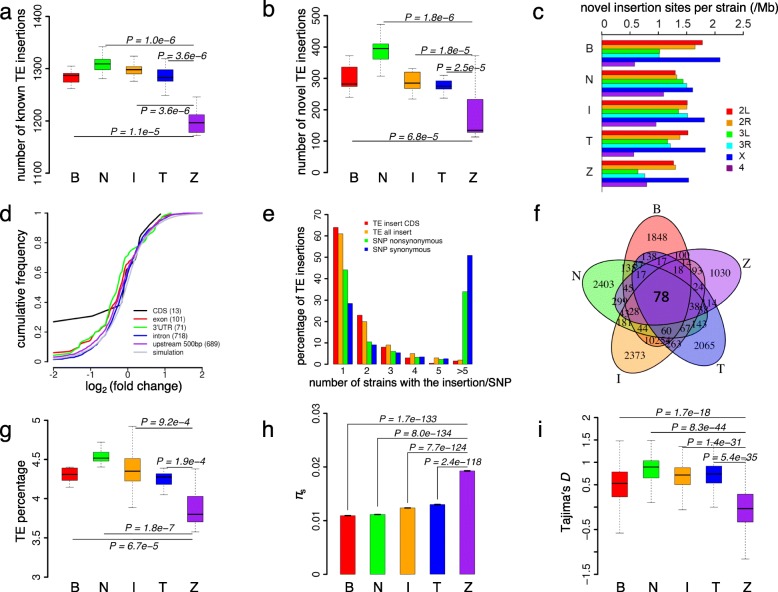Fig. 1.
The contents and polymorphisms of TE insertions in D. melanogaster from the Global Diversity Lines (GDL). The five populations are abbreviated as follows: B, Beijing (n = 14); I, Ithaca (n = 17); N, Netherland (n = 19); T, Tasmania (n = 17); Z, Zimbabwe (n = 14). a Boxplots of the numbers of known TE insertions (y-axis) across the five populations. The average copy number (± s.e.) in each strain is 1283.7 ± 3.3, 1297.4 ± 3.4, 1309.1 ± 3.5, 1290.5 ± 6.9 and 1204.3 ± 8.4 for the B, I, N, T, and Z population, respectively. b Boxplots of the numbers of novel TE insertions (y-axis) across the five populations. The average number (± s.e.) of novel insertions in each strain is 299.1 ± 11.1, 288.6 ± 7.1, 387.9 ± 10.3, 275.8 ± 5.0, and 171.5 ± 19.8 in the B, I, N, T, and Z population respectively. c Densities (insertions per Mb) of TE novel insertion sites on different chromosomes per strain in five populations. d Changes of gene expression caused by TE insertions in female adults. For each novel TE insertion in the genic regions in the 5 GDL strains that have transcriptome sequenced in females, we compared the expression level of the host genes in the strains that have the TE insertion vs. the strains that do not have the particular insertion. The x-axis is the log2 (fold change) of gene expression caused by a TE insertion. The y-axis is the cumulative probability of each insertion category. e Frequency spectra of novel TE insertions and SNPs from different functional categories. The x-axis is the number of strains that carry the particular category of TE insertions or SNPs, and the y-axis is the percentage of TE insertions or SNPs in each class that is segregating at that particular frequency. f Venn diagram of novel TE insertions across the five populations. g The percentages of genomic reads (y-axis) that are mapped to the TEs annotated in the reference genome across the five populations. h Barplots of πs in 10 kb bins across the five populations. i Boxplots of Tajima’s D in 10 kb bins across the five populations. KS tests were performed to test the differences in the statistic values across populations

